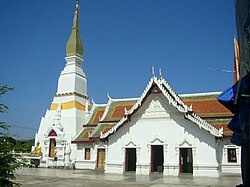Sakon Nakhon province
 From Wikipedia - Reading time: 10 min
From Wikipedia - Reading time: 10 min
Sakon Nakhon
สกลนคร | |
|---|---|
(Clockwise from top left) Nong Han, Phu Pha Yon National Park, Phra That Choeng Chum and Wat Phra That Choeng Chum, Phu Phan Mountains, Historic building in Ban Tha Rae, View of Nam Un Dam | |
| Nickname: Sakon (Thai: สกล) | |
| Motto(s): พระธาตุเชิงชุมคู่บ้าน พระตำหนักภูพานคู่เมือง งามลือเลื่องหนองหาน แลตระการปราสาทผึ้ง สวยสุดซึ้งสาวภูไท ถิ่นมั่นในพุทธธรรม ("Home of Phra That Choeng Chum. Home of Phu Phan Palace. The famous Nong Han lake. Fascinating Prasat Phueng. Beautiful Phu Thai women. The lands strong in Buddhism and Dharma.") | |
 Map of Thailand highlighting Sakon Nakhon province | |
| Country | |
| Capital | Sakon Nakhon |
| Government | |
| • Governor | Chusak Ruying |
| Area | |
• Total | 9,580 km2 (3,700 sq mi) |
| • Rank | 19th |
| Population (2024)[2] | |
• Total | |
| • Rank | 18th |
| • Density | 119/km2 (310/sq mi) |
| • Rank | 42nd |
| Human Achievement Index | |
| • HAI (2022) | 0.6292 "somewhat low" Ranked 54th |
| GDP | |
| • Total | baht 56 billion (US$1.9 billion) (2019) |
| Time zone | UTC+7 (ICT) |
| Postal code | 47xxx |
| Calling code | 042 |
| ISO 3166 code | TH-47 |
| Vehicle registration | สกลนคร |
| Website | sakonnakhon |
Sakon Nakhon Provincial Administrative Organization
องค์การบริหารส่วนจังหวัดสกลนคร | |
|---|---|
 | |
| Government | |
| • Type | Local administrative divisions |
| • Body | Sakon Nakhon Provincial Administrative Organization |
| • President | Narumon Sapso |
| Website | sakon-pao |
Sakon Nakhon (Thai: สกลนคร, pronounced [sā.kōn ná(ʔ).kʰɔ̄ːn]; Northeastern Thai: สกลนคร, pronounced [sā.kōn nà(ʔ).kʰɔ̂ːn]) is one of Thailand's seventy-six provinces (changwat). It lies in upper northeastern Thailand. Neighboring provinces are (from north clockwise) Nong Khai, Bueng Kan, Nakhon Phanom, Mukdahan, Kalasin, and Udon Thani. Its capital is Sakon Nakhon.
Toponymy
[edit]The word sakon originates from the Sanskrit word sakala (Devanagari: सकल) meaning 'entire', 'whole', or 'total', and the word nakhon from Sanskrit nagara (Devanagari: नगर) meaning 'town' or 'city'. Hence the name of the province literally means "city of cities".
Geography
[edit]The province is on the Khorat Plateau, not far from the Mekong. The Nong Han lake, the biggest natural lake of northeast Thailand, near the city of Sakon Nakhon, is a popular resort. The Phu Phan Mountains delimit the province to the south. The total forest area is 1,692 km2 (653 sq mi) or 17.7 percent of provincial area.[1]
National parks
[edit]There are three national parks, along with four other national parks, make up region 10 (Udon Thani) of Thailand's protected areas.
- Phu Pha Yon National Park, 829 km2 (320 sq mi)[5]: 57
- Phu Phan National Park, 665 km2 (257 sq mi)[5]: 7
- Phu Pha Lek National Park, 404 km2 (156 sq mi)[5]: 118
History
[edit]The history of Sakon Nakhon dates back to about three thousand years. Local legend says that Mueang Nong Han Luang, or presently Sakhon Nakhon, was built in the 11th century when the Khmer ruled this region. When the Khmer lost its power, the town was under the rule of Lan Xang or Lao Kingdom. It was renamed into "Mueang Chiang Mai Nong Han". When the town was under Siam, it was renamed again into "Sakhon Thawapi" in 1830, during King Rama III's reign, it was renamed "Sakon Nakhon".
Phu Phan Mountains in the area of Sakon Nakhon, especially Sawang Daen Din district, formerly a stronghold of the Communist Party of Thailand.[6]
Ethnic group
[edit]The Ethnic group of Sakon Nakhon are Chinese and Vietnamese with Tai Dam as well as Nyaw.[7][6]
Symbols
[edit]The provincial seal shows the Phrathat Choeng Chum, a Lao-style chedi built during the Ayutthaya period over a Khmer-style prang.
The provincial tree is the banaba or Queen's Crape Myrtle (Lagerstroemia speciosa). Black sharkminnow (Labeo chrysophekadion) is the provincial fish.[8]
Economy
[edit]Fish and rice are two of the major products of the region.[7]
Kho Khun Pon Yang Kham is branded as Thailand's best-quality beef, produced by Pon Yang Kham Breeding Cooperatives, which was incorporated in 1980 in Ban Pon Yang Kham in Mueang Sankhon Nakhon. It has created a great reputation for the province. Kho Khun Pon Yang Kham is regarded as "Thai Kobe beef".[9]
Transportation
[edit]Rail
[edit]Sakon Nakhon does not have a train service yet. People who want to travel to Sakon Nakhon by train can get off at Udon Thani Railway Station in neighboring province Udon Thani. Then take a local bus to Sakon Nakhon, the distance is approximately 156 km.
Roads
[edit]Route 22 leads north to Udon Thani, 160 km distant, and east to Nakhon Phanom (91 km) and the border with Laos. Route 223 leads south to That Phanom (76 km). Route 213 leads west to Kalasin (131 km).[citation needed]
Air
[edit]There is a regional airport, Sakon Nakhon Airport, on the north side of the city.[10]
Health
[edit]Sakon Nakhon's main hospital is Sakon Nakhon Hospital, operated by the Ministry of Public Health.
Administrative divisions
[edit]
Provincial government
[edit]The province is divided into 18 districts (amphoes). The districts are further divided into 125 subdistricts (tambons) and 1,323 villages (mubans).
Local government
[edit]As of 26 November 2019 there are:[11] one Sakon Nakhon Provincial Administration Organisation (ongkan borihan suan changwat) and 66 municipal (thesaban) areas in the province. Sakon Nakhon has city (thesaban nakhon) status. Further 65 subdistrict municipalities (thesaban tambon). The non-municipal areas are administered by 74 Subdistrict Administrative Organisations - SAO (ongkan borihan suan tambon).
Human achievement index 2022
[edit]Since 2003, United Nations Development Programme (UNDP) in Thailand has tracked progress on human development at sub-national level using the Human achievement index (HAI), a composite index covering all the eight key areas of human development. National Economic and Social Development Board (NESDB) has taken over this task since 2017.[3]
| Rank | Classification |
| 1 - 13 | "high" |
| 14 - 29 | "somewhat high" |
| 30 - 45 | "average" |
| 46 - 61 | "somewhat low" |
| 62 - 77 | "low" |
| Map with provinces and HAI 2022 rankings |

|
Important places
[edit]Sakon Nakhon is a location of many important places, apart from Nong Han and Phu Phan Mountains, include
- Phu Phan National Park
- Phu Pha Yon National Park
- Phu Pha Lek National Park
- Nam Un Dam
- Wat Phra That Choeng Chum
- Phu Phan Rajanivet Palace
Events and festivals
[edit]- Prasat Pueng Procession: held during the 12th-15th day of waxing moon in October to mark the end of Buddhist Lent. On the night of 13thday, people will join hands in decoration Prasat Pueng (wax castle) at Ming Mueang Field. The 14thday, wax castel from various temples will join the procession, roaming the municipality to Wat Phra That Choeng Chum. Isan people believe that the wax will welcome Buddha who comes back from the heaven to help all creatures on earth.
- Regatta: held synchronically with the Prasat Pueng Procession, the ancient regatta will be held at Phang Thong Pond or Tha Nang Ap, Ban Tha Wat.
- Tha Rae Star Procession: is a tradition unique to the world and has been held annually during Christmas Eve since 1982, the celebrations and procession will take place at Ban Tha Rae, home to Thailand's largest Roman Catholic community, in Mueang Sakhon Nakhon.[12]
Notable people
[edit]Born in Sakhon Nakhon
[edit]- Dusit Chalermsan: professional footballer, football coach
- Suree Sukha: professional footballer
- Surat Sukha: professional footballer
- Sinthaweechai Hathairattanakool: professional footballer
- Poonsawat Kratingdaenggym: a world-class professional boxer
See also
[edit]Gallery
[edit]-
3,000-year-old petroglyphs at Phu Pha Yon National Park
-
Sakon Nakhon City Gate
-
Faculty of Agricultural Technology, Sakon Nakhon Rajabhat University
-
Wax Castle Procession
References
[edit]- ^ a b "Table 2 Forest area Separate province year 2019". Royal Forest Department. Retrieved 6 April 2021.
- ^ "Official statistics registration systems". Department of Provincial Administration (DOPA). Retrieved 10 February 2025, year 2024 >provincial level >Excel File >no.47
{{cite web}}: CS1 maint: postscript (link) - ^ a b "ข้อมูลสถิติดัชนีความก้าวหน้าของคน ปี 2565 (PDF)" [Human Achievement Index Databook year 2022 (PDF)]. Office of the National Economic and Social Development Council (NESDC) (in Thai). Retrieved 12 March 2024, page 70
{{cite web}}: CS1 maint: postscript (link) - ^ "Gross Regional and Provincial Product, 2019 Edition". <>. Office of the National Economic and Social Development Council (NESDC). July 2019. ISSN 1686-0799. Retrieved 22 January 2020.
- ^ a b c "ข้อมูลพื้นที่อุทยานแห่งชาติ ที่ประกาศในราชกิจจานุบกษา 133 แห่ง" [National Park Area Information published in the 133 Government Gazettes]. Department of National Parks, Wildlife and Plant Conservation (in Thai). December 2020. Archived from the original on 7 August 2022. Retrieved 1 November 2022.
- ^ a b Lyovarin, Win (1997). ประชาธิปไตยบนเส้นขนาน [Democracy, Shaken and Stirred] (in Thai). Bangkok: Dok Ya. pp. 255–256. ISBN 9748585476.
- ^ a b "จังหวัดสกลนคร เตรียมจัดงานมหกรรมภูมิปัญญาพื้นบ้านมูนมังอีสาน ครั้งที่ 11 ภายใต้ชื่อ "ข้าว ปลา ป่า เกลือ"" [Sakon Nakhon preparing to organize the 11th Moonmang-Isan Folklore Festival under the title "Rice, Salt, Wild, Fish"]. NNT (in Thai). 2020-01-10. Retrieved 2020-04-22.
- ^ admin (2015-06-08). "สัตว์น้ำประจำจังหวัดสกลนคร" [Provincial aquatic animal]. Charoensinsuka "Phokham's Memorial" School (in Thai). Archived from the original on 2019-01-17. Retrieved 2020-04-22.
- ^ Chantanusornsiri, Wichit (2018-08-23). "The Kobe beef of Isan takes off". Bangkokpost. Retrieved 2020-04-22.
- ^ "Sakon Nakhon Airport". OurAirports. Archived from the original on 17 April 2023. Retrieved 3 February 2013.
- ^ "Number of local government organizations by province". dla.go.th. Department of Local Administration (DLA). 26 November 2019. Retrieved 10 December 2019.
56 Sakon Nakhon: 1 PAO, 1 City mun., 65 Subdistrict mun., 74 SAO.
- ^ Svasti, Pichaya (2017-12-21). "Christmas Star parades". Bangkokpost. Retrieved 2020-04-22.
External links
[edit] Sakon Nakhon travel guide from Wikivoyage
Sakon Nakhon travel guide from Wikivoyage- Provincial page from the Tourist Authority of Thailand
- Website of province Archived 2020-11-17 at the Wayback Machine (Thai only)
 KSF
KSF













